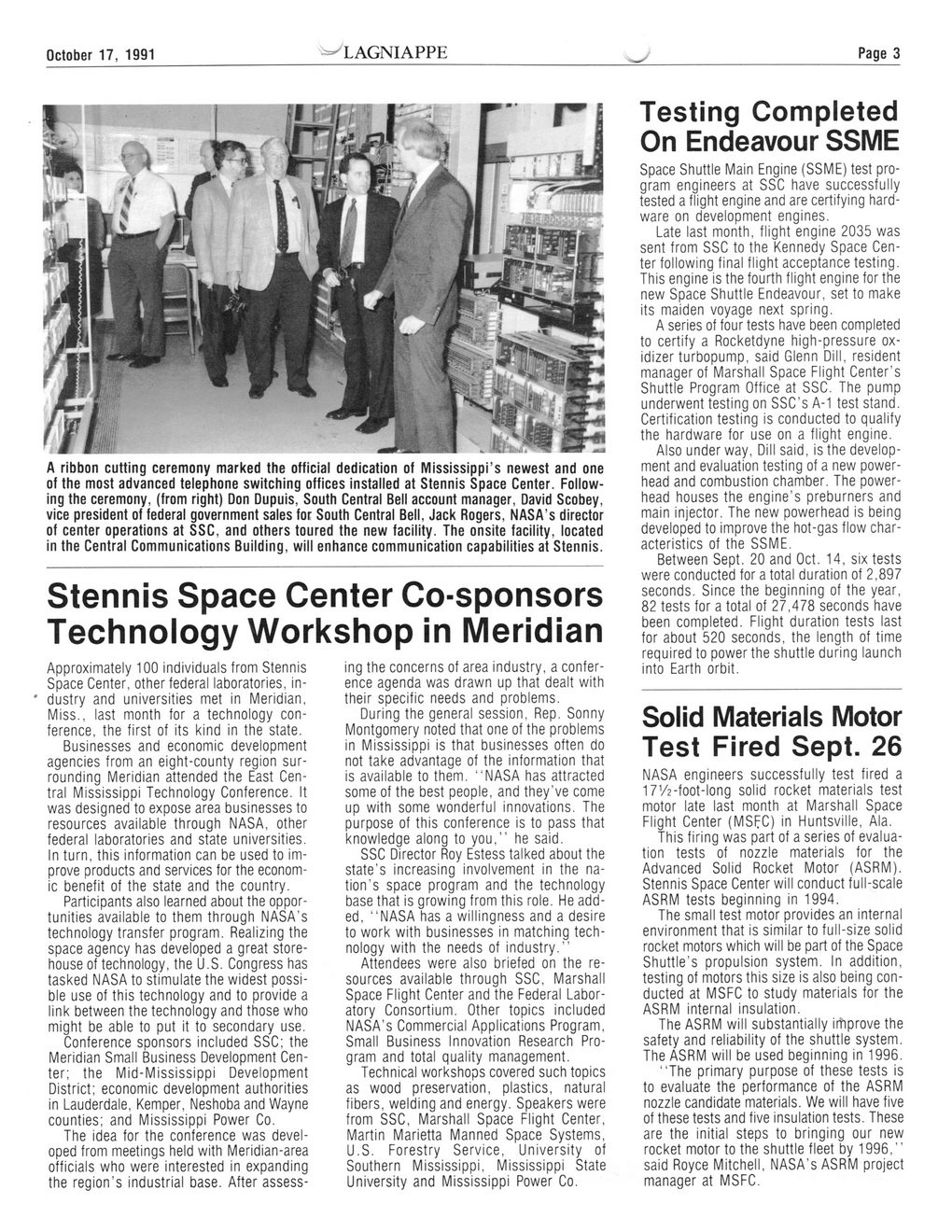This text was obtained via automated optical character recognition.
It has not been edited and may therefore contain several errors.
October 17, 1991 ■^LAGNIAPPE Page 3 A ribbon cutting ceremony marked the official dedication of Mississippi’s newest and one of the most advanced telephone switching offices installed at Stennis Space Center. Following the ceremony, (from right) Don Dupuis, South Central Bell account manager, David Scobey, vice president of federal government sales for South Central Bell, Jack Rogers, NASA’s director of center operations at SSC, and others toured the new facility. The onsite facility, located in the Central Communications Building, will enhance communication capabilities at Stennis. Stennis Space Center Co-sponsors Technology Workshop in Meridian Approximately 100 individuals from Stennis Space Center, other federal laboratories, in-* dustry and universities met in Meridian, Miss., last month for a technology conference, the first of its kind in the state. Businesses and economic development agencies from an eight-county region surrounding Meridian attended the East Central Mississippi Technology Conference. It was designed to expose area businesses to resources available through NASA, other federal laboratories and state universities. In turn, this information can be used to improve products and services for the economic benefit of the state and the country. Participants also learned about the opportunities available to them through NASA's technology transfer program. Realizing the space agency has developed a great storehouse of technology, the U.S. Congress has tasked NASA to stimulate the widest possible use of this technology and to provide a link between the technology and those who might be able to put it to secondary use. Conference sponsors included SSC; the Meridian Small Business Development Center; the Mid-Mississippi Development District; economic development authorities in Lauderdale, Kemper, Neshoba and Wayne counties; and Mississippi Power Co. The idea for the conference was developed from meetings held with Meridian-area officials who were interested in expanding the region's industrial base. After assess- ing the concerns of area industry, a conference agenda was drawn up that dealt with their specific needs and problems. During the general session, Rep. Sonny Montgomery noted that one of the problems in Mississippi is that businesses often do not take advantage of the information that is available to them. “NASA has attracted some of the best people, and they’ve come up with some wonderful innovations. The purpose of this conference is to pass that knowledge along to you,” he said. SSC Director Roy Estess talked about the state’s increasing involvement in the nation's space program and the technology base that is growing from this role. He added, "NASA has a willingness and a desire to work with businesses in matching technology with the needs of industry." Attendees were also briefed on the resources available through SSC, Marshall Space Flight Center and the Federal Laboratory Consortium. Other topics included NASA's Commercial Applications Program, Small Business Innovation Research Program and total quality management. Technical workshops covered such topics as wood preservation, plastics, natural fibers, welding and energy. Speakers were from SSC, Marshall Space Flight Center, Martin Marietta Manned Space Systems, U.S. Forestry Service, University of Southern Mississippi, Mississippi State University and Mississippi Power Co. Testing Completed On Endeavour SSME Space Shuttle Main Engine (SSME) test program engineers at SSC have successfully tested a flight engine and are certifying hardware on development engines. Late last month, flight engine 2035 was sent from SSC to the Kennedy Space Center following final flight acceptance testing. This engine is the fourth flight engine for the new Space Shuttle Endeavour, set to make its maiden voyage next spring. A series of four tests have been completed to certify a Rocketdyne high-pressure oxidizer turbopump, said Glenn Dill, resident manager of Marshall Space Flight Center's Shuttle Program Office at SSC. The pump underwent testing on SSCs A-1 test stand. Certification testing is conducted to qualify the hardware for use on a flight engine. Also under way, Dill said, is the development and evaluation testing of a new power-head and combustion chamber. The power-head houses the engine's preburners and main injector. The new powerhead is being developed to improve the hot-gas flow characteristics of the SSME. Between Sept. 20 and Oct. 14, six tests were conducted for a total duration of 2,897 seconds. Since the beginning of the year, 82 tests for a total of 27,478 seconds have been completed. Flight duration tests last for about 520 seconds, the length of time required to power the shuttle during launch into Earth orbit. Solid Materials Motor Test Fired Sept. 26 NASA engineers successfully test fired a 171/2-foot-long solid rocket materials test motor late last month at Marshall Space Flight Center (MSFC) in Huntsville, Ala. This firing was part of a series of evaluation tests of nozzle materials for the Advanced Solid Rocket Motor (ASRM). Stennis Space Center will conduct full-scale ASRM tests beginning in 1994. The small test motor provides an internal environment that is similar to full-size solid rocket motors which will be part of the Space Shuttle's propulsion system. In addition, testing of motors this size is also being conducted at MSFC to study materials for the ASRM internal insulation. The ASRM will substantially irhprove the safety and reliability of the shuttle system. The ASRM will be used beginning in 1996. "The primary purpose of these tests is to evaluate the performance of the ASRM nozzle candidate materials. We will have five of these tests and five insulation tests. These are the initial steps to bringing our new rocket motor to the shuttle fleet by 1996,'' said Royce Mitchell, NASA's ASRM project manager at MSFC.

NASA Document (069)